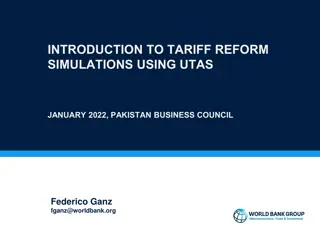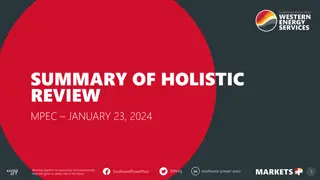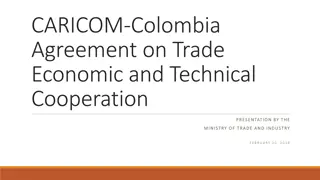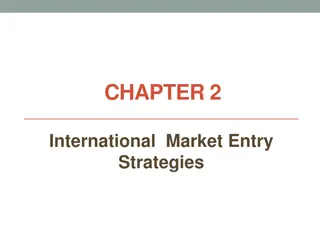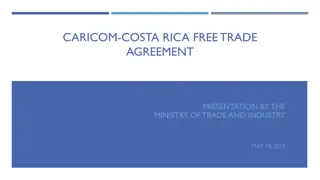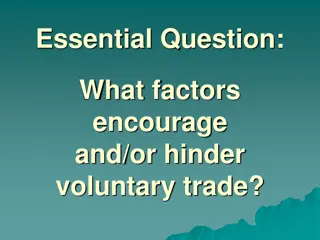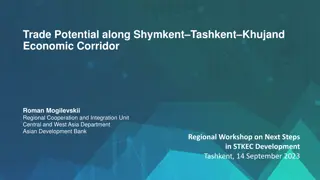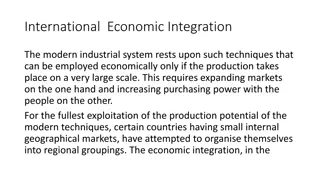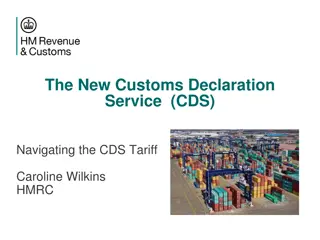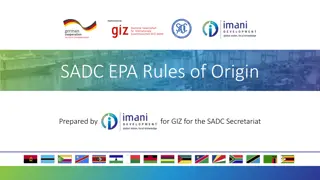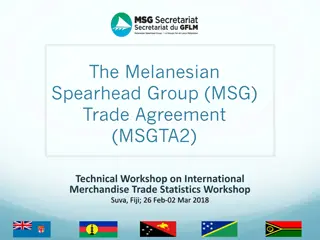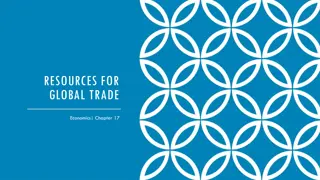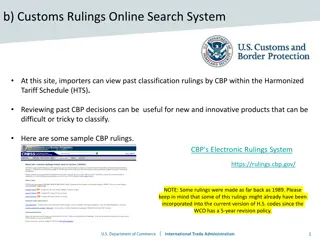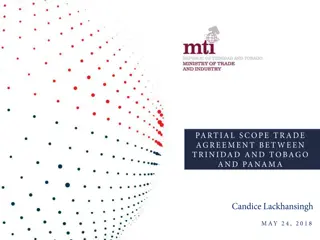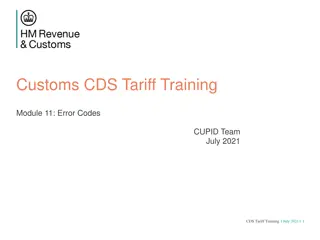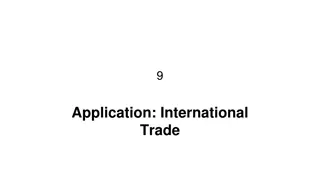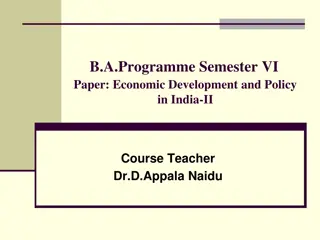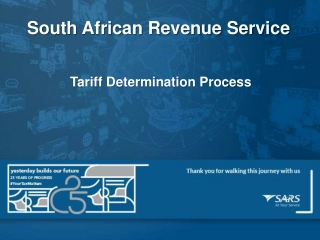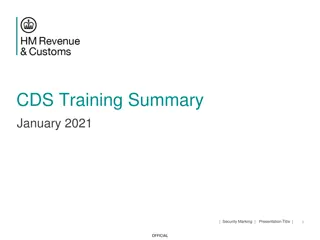Understanding Trade Barriers and Tariff Classification
Explore the concept of trade barriers, including tariff and non-tariff barriers, their objectives, types, and classification. Learn about the benefits of tariff barriers, like discouraging imports and protecting home industries, and the classification of non-tariff barriers such as the quota system and import licensing. Understanding these barriers is crucial for navigating international trade scenarios effectively.
Download Presentation

Please find below an Image/Link to download the presentation.
The content on the website is provided AS IS for your information and personal use only. It may not be sold, licensed, or shared on other websites without obtaining consent from the author. Download presentation by click this link. If you encounter any issues during the download, it is possible that the publisher has removed the file from their server.
E N D
Presentation Transcript
GLOBAL FRAMEWORK FOR EXPORT MARKETING MODULE 2
TRADE BARRIERS artificial restrictions imposed by countries on free movement of goods and services in between different countries/nations OBJECTIVES OF TRADE BARRIERS 1. To protect domestic industries 2. To promote new industries 3. To maintain favorable balance of trade 4. To conserve foreign exchange reserves 5. To protect national economy 6. To earn extra revenue 7. To counteract trade barriers 8. To encourage the use of domestic production
TYPES OF TRADE BARRIERS A) TARIFF BARRIER- It refers to the taxes/ custom duties and other levies imposed on internationally traded commodities when they cross the national boundaries B) NON TARIFF BARRIER Any measure other than the tariffs introduced for restricting the entry of foreign goods can be treated as a non tariff barrier. They are quantitative restrictions imposed.
CLASSIFICATION OF TARIFF BARRIERS A) On the basis of origin and destination of the goods i. Export Duty ii. Import Duty iii. Transit Duty B) On the basis of quantification of the tariff i. Specific duty for e.g. Rs 50 on each unit of TV imported ii. Ad- Valorem Duty value of the commodity iii. Compound duty mix of specific and ad valorem
C) On the basis of purpose i) Revenue tariff ii) Protective tariff iii) Anti dumping duties iv) Countervailing duties D) On the basis of Trade relation i) Single column tariff ii) Double column tariff iii) Triple column tariff lower rate, higher rate and preferential rate
Benefits of tariff barriers 1. Discourage imports 2. Protection to home industry 3. Reduction in consumption of foreign products 4. Revenue to the government 5. Removal of trade deficit 6. Encouragement to R&D activities 7. Additional employment creation
Classification of Non Tariff barriers 1. Quota system limits the quantity of the import i. Tariff Quota ii. Unilateral Quota iii. Bilateral Quota iv. Mixing quota 2. Import Licencing and Domestic content requirements 3. Consular formalities 4. Preferential treatment through trading blocs 5. Customs regulation 6. State Trading 7. Foreign exchange regulations 8. Fixing product standards
Distinguish between Tariff and Non Tariff Barriers 1. Meaning 2. Kinds 3. Effect 4. Effectiveness 5. Effects on import 6. Revenue earning capacity 7. Time for effectiveness
POSITIVE IMPACT OF TRADE BARRIERS 1. Protection to domestic industries 2. Additional revenue to the Government 3. Improvement in BOT and BOP 4. Conservation of foreign exchange 5. Accelerates growth process
NEGATIVE IMPACTOF TRADE BARRIERS 1. Restricts free movement of goods and services 2. Volume of world trade reduces 3. Countries are artificially kept away from each other 4. Production activities are adversely affected 5. Countries with surplus production are unable to utilize it fully
TRADING BLOCS / ECONOMIC GROUPINGS Trading Bloc is the formation of group of countries for mutual benefits TYPES of TRADING BLOCS 1. Free Trade Area 2. Customs Union 3. Common Market 4. Economic Union
OBJECTIVES OF ECONOMIC GROUPINGS(Positive effects of economic groupings) 1. To reduce/ eliminate trade barriers 2. To promote growth of the region 3. To promote free trade among member countries 4. To strengthen political, economic, social and cultural relations 5. To provide assistance 6. To promote economic growth and employment opportunities
NEGATIVE IMPACT OF TRADING BLOCS 1. Competition is restricted 2. Problem before non members 3. Collective bargaining by member countries 4. Harmful effect on global trade
MAJOR ECONOMIC GROUPINGS OF THE WORLD EU EUROPEAN UNION 1STJANUARY 1958 The most powerful and successful trading bloc in the world consisting of Belgium, France, Republic of Germany, Italy, Luxembourg and Netherlands EU constitutes India s largest single trading partner
SAARC(SOUTH ASIAN ASSOCIATION FOR REGIONAL CO-OPERATION) FORMED IN THE YEAR 1985 India, Pakistan, Sri Lanka, Bangladesh, Nepal, Bhutan and Maldives. Later on in 2008 , AFGANISTHAN joined this group Objectives of SAARC To develop cooperation among the member countries Accelerate economic growth Mutual assistance Promote the welfare of the people in the region
WORLD TRADE ORGANIZATION Started functioning from 1stJanuary, 1995 Result of Uruguay round of negotiations Successor to GATT( General Agreement on Tariff and Trade) 164 countries are the members of the WTO representing 98 percent of the world trade OBJECTIVES OF WTO:- Free Trade Growth of LDCs Protection and preservation of the environment Raising the standard of living Creation of full employment situation
FUNCTIONS OF WTO 1. Promote trade without discrimination 2. Resolve the trade disputes 3. Implement tariff cuts 4. Monitor the development in the world economy 5. Collect the trade statistics 6. Act as a watchdog of international trade
WTO AGREEMENTS 1. TRIPS ( Trade related Intellectual property rights (POSITIVE IMPLICATIONS) TRIPS agreement gives protection to patented products- EMR ( exclusive marketing rights) Gives encouragement to R&D activities GIS( Geographic Indication Status)- e.g. India has acquired GIS to Darjeeling tea (NEGATIVE IMPLICATIONS) TRIPS agreement is favorable only to the developed countries Extends to micro organisms also
2. TRIMS- Trade related Investment measures Purpose was to avoid discrimination against foreign capital by the government The main provisions :- All restrictions on foreign capital should be removed No restriction to be imposed on any area of investment Foreign investor will be given the same rights in the matter of investment Imports of raw materials will be allowed freely
3. GATS-General Agreement on Trade in Services Impact is unfavorable to India and other developing countries Positive implications of GATS:- Global trade in services will increase There is a considerable expansion of services sector Developing countries secured many benefits due to opening of services sector by WTO Negative implications competition between foreign and domestic firms Outflow of foreign exchange from developing countries Impact of GATS unfavorable to developing countries
4. Agreement on Agriculture (AOA) Developed countries to reduce their subsidies by 20 percent in six years and developing nations by 13 percent in ten years Positive implications of Agreement on Agriculture 1. Encouragement to global trade in agricultural commodities by reducing subsidies 2. Developed countries were successful in exporting agricultural products to developing countries Negative implications:- 1. Majority of the countries could not export agricultural products abroad 2. Developed countries failed to open up their markets to developing countries
TFA ( trade facilitation Agreement)(201) Latest WTO agreement Bali s ministerial meeting Contains provisions for the movement, release and clearance of goods , including goods in transit Will be effective once 2/3th of the members have formally accepted the agreement
OVERSEAS MARKET RESEARCH Systematic design, collection, recording , analysis and interpretation and reposting of information pertinent to a marketing decision facing a company operating internationally Need for Market Research- to address the following issues:- Which of the products are suitable Which markets are promising and profitable Requirements and expectations of the buyers How to make the product popular and agreeable to foreign buyers
NEED AND IMPORTANCE OF MARKET RESEARCH 1. Selection of Target markets 2. Selection of suitable products 3. Appropriate market entry 4. Appropriate product packaging 5. Product positioning 6. Ascertaining consumer needs and wants 7. Appropriate pricing decisions 8. Promotional campaigns
STEPS IN SELECTING OVERSEAS MARKETS 1. Defining the overseas marketing objectives of the firm 2. Deciding the parameters for selection of target markets 3. Preliminary screening 4. Shortlisting of the overseas markets 5. Detailed scrutiny of the short listed markets 6. Final evaluation 7. Actual entry in the overseas market 8. Follow up of company s performance in selected markets
MAJOR FACTORS FOR FOREIGN MARKET SELECTION A) firm related factors:- 1. Varied objectives 2. Business strategy 3. INTERNATIONAL OREIENTATION :- Douglas Wind and Pert mutter- EPRG framework Ethnocentric approach:- (Home country orientation) Polycentric approach (Host country orientation) Regiocentric approach(Regional orientation) Geocentric approach(world orientation)
4. Company resources 5. Management Vision (B) MARKET FACTORS 1. Economic policy 2. Economic factors 3. Business Regulations 4. Infrastructure 5. Currency stability 6. Degree of competition 7. Socio cultural factors 8. Trends in domestic production and consumption


